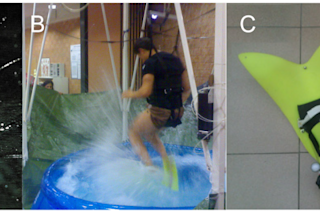Figure 1. Running on water in Basilisk lizard (A, Basiliscus basiliscus), and human in our laboratory conditions (B). The fins used are illustrated in C.These three Italian scientists deserve a prize for the most superhero-inspired experiment: they first used mathematical modeling to predict that humans would be able to walk on water in reduced gravity, and then they actually tested it with special flipper shoes and a kiddie pool! As they note in their introduction, "Notwithstanding various internet hoaxes, humans are apparently incapable of walking or running on water." (Never have I wished so much for a citation as at the end of that sentence... please amend this oversight in the comments!) And boy, do I wish my Ph.D. dissertation was half as fun as the experiments in the video below. Seriously--if you need someone to go on a lunar mission to splash across a kiddie pool in order to ...
Study shows that you can run on water...on the moon.
Discover if humans can truly run on water with math and a reduced gravity simulator, just like the Basilisk lizard!
More on Discover
Stay Curious
SubscribeTo The Magazine
Save up to 40% off the cover price when you subscribe to Discover magazine.
Subscribe













